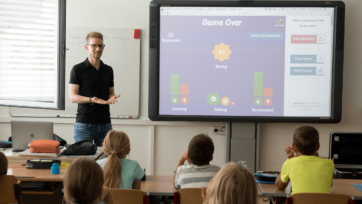Once Upon a Narrative – The Power of Storytelling in the Classroom
by Rachel Borthwick

Riding the influencer wave: How to get your resources into the hands of Aussie teachers.
Utter the words ‘once upon a time’ and our programmed response will likely conjure up visions of damsels in distress (where are all the heroines?!), poisoned fruit, ogres and strapping young princes on horseback ready to save the day.
If that all sounds predictable and a little prescriptive, there’s a good reason: This is the art of storytelling.
Storytelling, at its heart, is about disseminating shared and familiar experiences with the goal of imparting a moral value on the audience. And it is one of the most powerful tools you can wield in your classroom to build a sense of community, connectedness and belonging; the very things that have been on educators’ radars as requiring urgent action.
Published in 2008, The Melbourne Declaration on the Educational Goals for Young Australians centres on two essential objectives:
Goal 1: Australian schooling promotes equity and excellence
Goal 2: All young Australians become successful learners, confident and creative individuals, and active and informed citizens
The declaration ‘acknowledges major changes in the world that are placing new demands on Australian education.’ In the fifteen years that have since passed, unparalleled changes to our world, not least the world of education, has necessitated a unified approach to the way in which we include and empower our students in their learning.
In an increasingly digitised and disease-ridden world, isolation and disconnection are very real social challenges that have extended into our schools. It is complicated, but the solution could be as simple as engagement.
Engaging students through storytelling is nothing new. At the very core of their culture, Aboriginal Australians use oral storytelling to communicate concepts, beliefs and lore from generation to generation. But have we truly harnessed its potential in the classroom?
According to Henry Jenkins, Provost Professor of Communication, Journalism, Cinematic Arts and Education at the University of Southern California, ‘every story needs someone to hear it, see it, experience it, evolve it, share and perpetuate it.’
It is the predictability and prescriptiveness (or ‘rules’) that provides the safety, familiarity and ability to buy-in for all students under our tutelage. When they are involved in the storytelling process as the audience, characters, co-creators, disseminators or any combination of the aforementioned, learning experiences are enriched and authentic. Students feel part of the learning experience, make personal connections with the story and are given the opportunity to learn about more complex concepts in a familiar format.
Memory is also activated when a lesson has a narrative thread woven throughout. This is reiterated by Dr Simon McIntyre, Director of Learning and Innovation, UNSW Art and Design. ‘We remember things that happen to us in our lives by stripping away extraneous details, and condensing experiences into simplified narratives,’
Here are some simple ways to incorporate storytelling into your daily routine:
- Introduce a new concept by using characters the students are familiar with. Perhaps you could enlist the help of Elsa and Anna from Frozen to help explain the melting polar ice caps?
- Students can write a script inserting themselves as characters in order to solve a real world problem. Is there a playground waste problem happening at lunchtime? What action will the characters take?
- Bring a difficult concept to life. Teaching students about percentages? Why not tell a story about how you used to visit the canteen at the end of lunch because the cheese toasties were reduced to half price? Work with the students to calculate how much you would have saved over the course of a year because you were a savvy diner!
- Create a box of images cut from magazines, brochures, newspapers or printed from the internet that can be readily accessed by students. Model how to select 3-6 images which can then be used as prompts for short oral storytelling.
Storytelling Is one of the oldest forms of teaching. By tapping into its myriad benefits, we can engage our students and prime them for a more connected experience in our classrooms.
Next Steps?
Contact Kimberlin Education to gain access to our storytelling resources created by teachers, for teachers.




